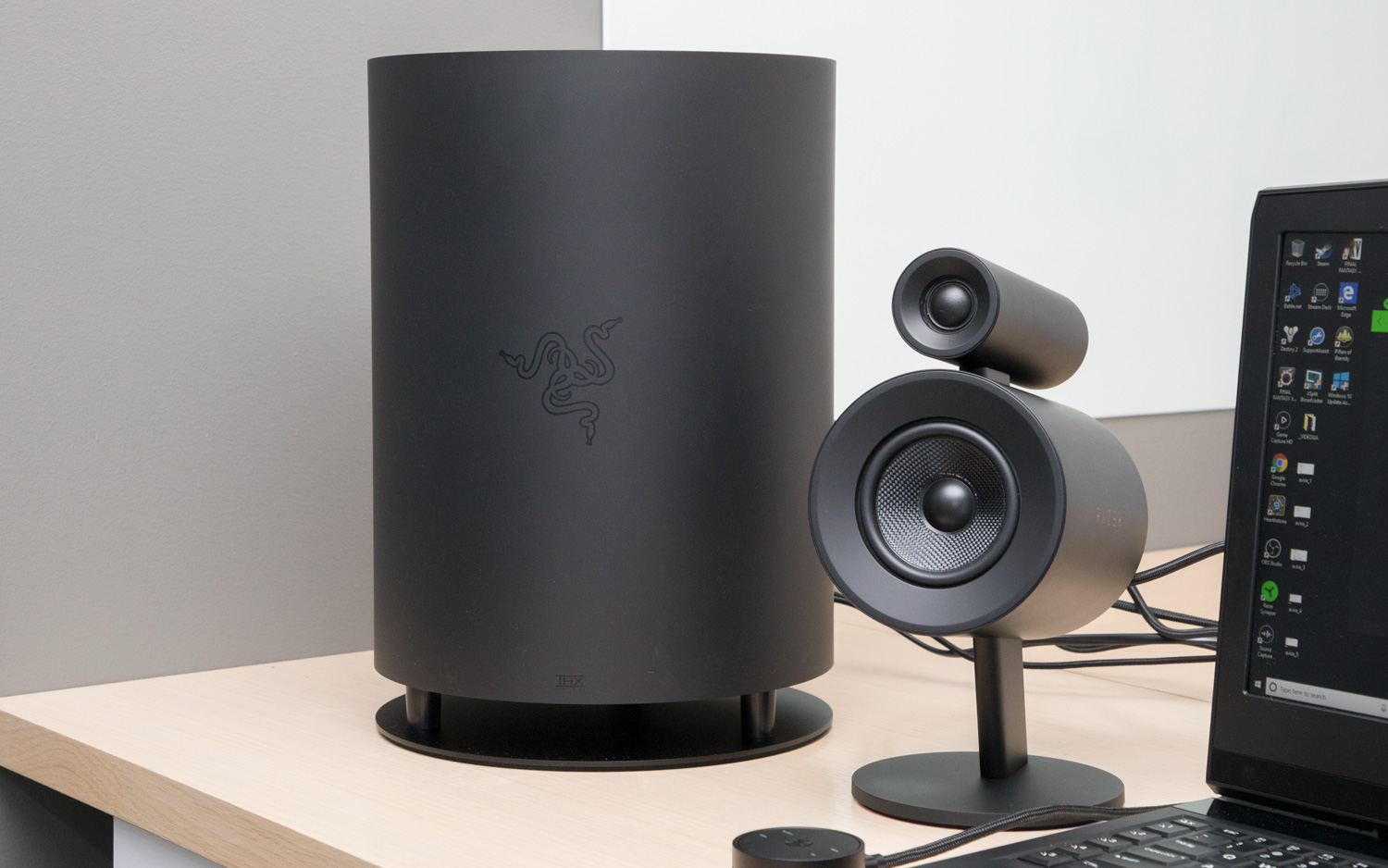Tom's Guide Verdict
The Razer Nommo Pro is a gorgeous, robust gaming speaker set, with a few colorful flourishes — and a high price.
Pros
- +
Robust sound
- +
Four simultaneous sources
- +
Customizable software
Cons
- -
Expensive
- -
Short cables
- -
Lackluster lighting
Why you can trust Tom's Guide
The Razer Nommo Pro is a gorgeous, robust gaming speaker set, with a few colorful flourishes and a variety of useful modes. That may make it sound like this would be an easy recommendation — until you take into account that the system costs $500. Considering that the average console costs about $300 and the average gaming PC costs about $1,000, not even audiophiles can make this investment lightly. (Nongaming speaker setups can range from $150 up to $700, with varying degrees of quality.)
To be fair, the Nommo Pro goes all out to earn its price. The two big speakers have a clever, inventive design and provide robust sound. The subwoofer provides steady bass that won't shake the walls apart (unless you really want it to). You can even switch relatively painlessly between THX-certified stereo sound and rich Dolby virtual surround sound.
If gaming takes center stage in your living room — especially if you have both a console and a living-room PC — the Nommo could be exactly what you're looking for to split the difference between gaming and other forms of entertainment. Otherwise, a less expensive speaker system could probably deliver a comparable experience.
Design
The Nommo Pro consists of four parts: a huge, cylindrical subwoofer (15.4 x 10.6 inches); two desktop speakers (10.5 x 5.1 inches each); and a small, circular USB control dongle.
You'll need to wire the whole 27-pound system together, which is a little disappointing, for two reasons. First of all, in such an expensive system, one wonders if the USB control dongle could have been a wireless remote-control peripheral instead. Second, all of the included cables are very short, so you'll need to keep your whole setup very close together. This could be inconvenient if your entertainment center fills your whole living room wall.
Once it's all set up, though, the Nommo Pro has a kind of big, plain, straightforward appeal. The subwoofer bears an unfortunate resemblance to a futuristic garbage can, but the speakers themselves are attractive cylinders with small protrusions on top that handle high-frequency sounds.
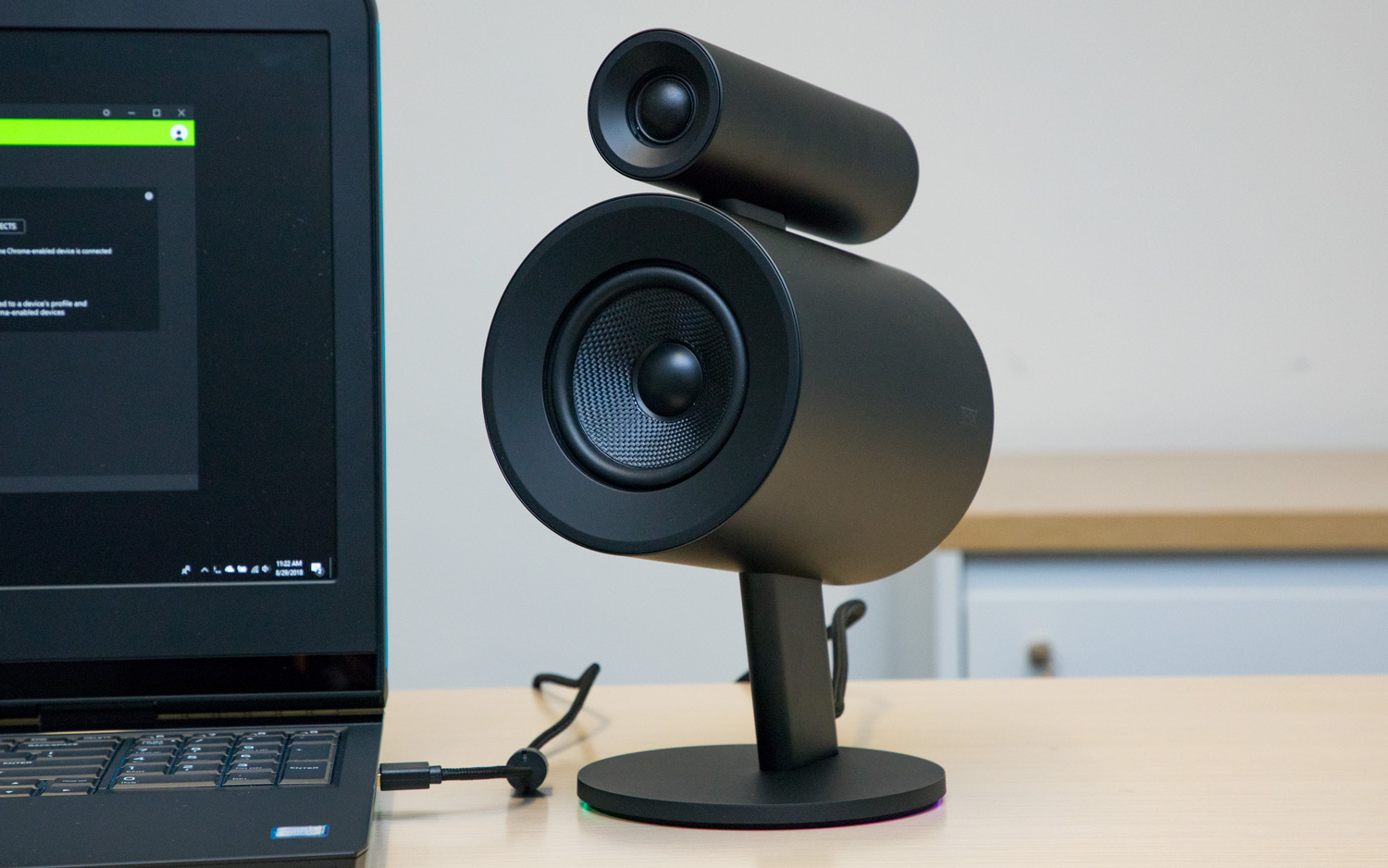
My only issue with the Nommo Pro's appearance is that while you technically get Razer's extremely attractive Chroma lighting, you get it in the most marginal way possible. At the bottom of each speaker, there's a thin LED strip with full RGB customization. It's tiny, and unless you have a black desk, you'll barely ever see it. After experiencing the impressive lighting on Logitech's G560 speakers, I was hoping for at least an LED strip around the face of the speakers, too.
Get instant access to breaking news, the hottest reviews, great deals and helpful tips.
I had the Nommo Pro connected to my phone, a gaming laptop and an Xbox One, all at the same time, switching between them at the press of a button.
Another design decision worth noting is that it's possible to connect the Nommo Pro to a variety of sources simultaneously, then switch between them effortlessly with the control dongle. As long as you have all of your systems in close proximity, you can connect to the speakers via USB, optical audio cable, Bluetooth and analog cable.
MORE: 12 Cheap Bluetooth Speakers (Under $50) Ranked
Naturally, optical audio is going to get you the best sound, but you can control the settings for each connection, provided you hook the Nommo Pro up to a computer running Razer software (more on that later). Not everyone's setup is going to look like this, but at one point, I had the Nommo Pro connected to my phone, a gaming laptop and an Xbox One, all at the same time, switching between them at the press of a button. It was incredibly convenient and made everything from music, to games to streaming videos sound amazing.
Gaming Performance
Provided you have enough space (and enough wire slack) to get the Nommo Pro up and running properly, it sounds absolutely gorgeous. I ran it through a variety of games on both PC and Xbox One, using both the USB and optical audio connections.
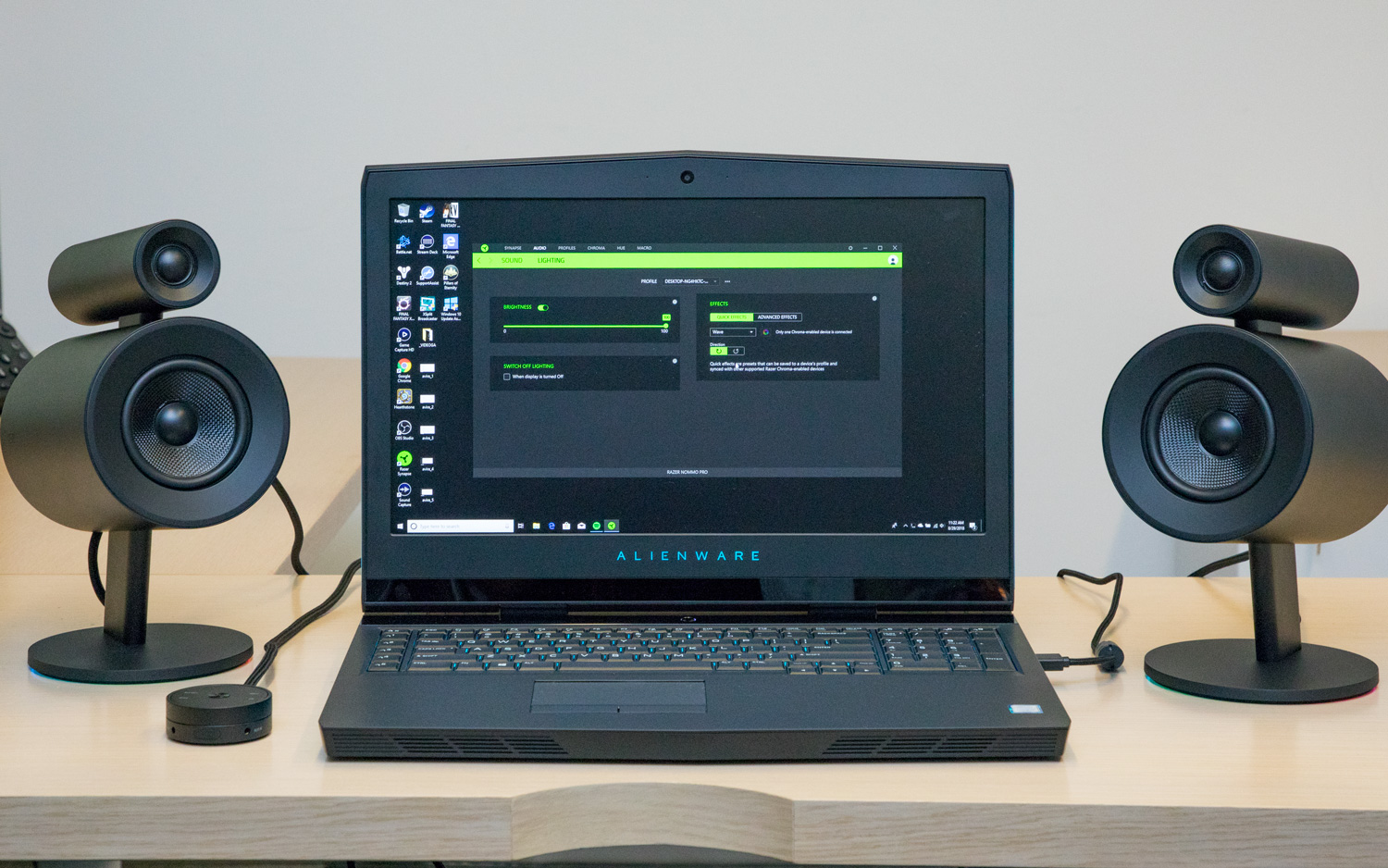
Whether I was shielding allies as D.Va in Overwatch, or listening to intense character confrontations in The Walking Dead: The Final Season, or humming along with the old-school beats of Bloodstained: Curse of the Moon, the Nommo Pro produced faithful, balanced and nuanced sound.
Part of the reason the Nommo Pro works so well is that it can create directional sound with roughly the same fidelity as a good pair of headphones. (I should point out, though, that I tested the system for single-player and casual multiplayer sessions; I couldn't vouch for its utility as a tool for those looking to climb the competitive ranks.)
Whether I was shielding allies as D.Va in Overwatch or listening to intense character confrontations in The Walking Dead: The Final Season, the Nommo Pro produced faithful, balanced and nuanced sound.
The setup instructions advise you to point the speakers diagonally, aimed right toward your ears, rather than facing out toward the room in general. This, along with the system's THX Spatial Audio option, gives a lot of depth and fidelity to games in which you need to know your opponent's location.
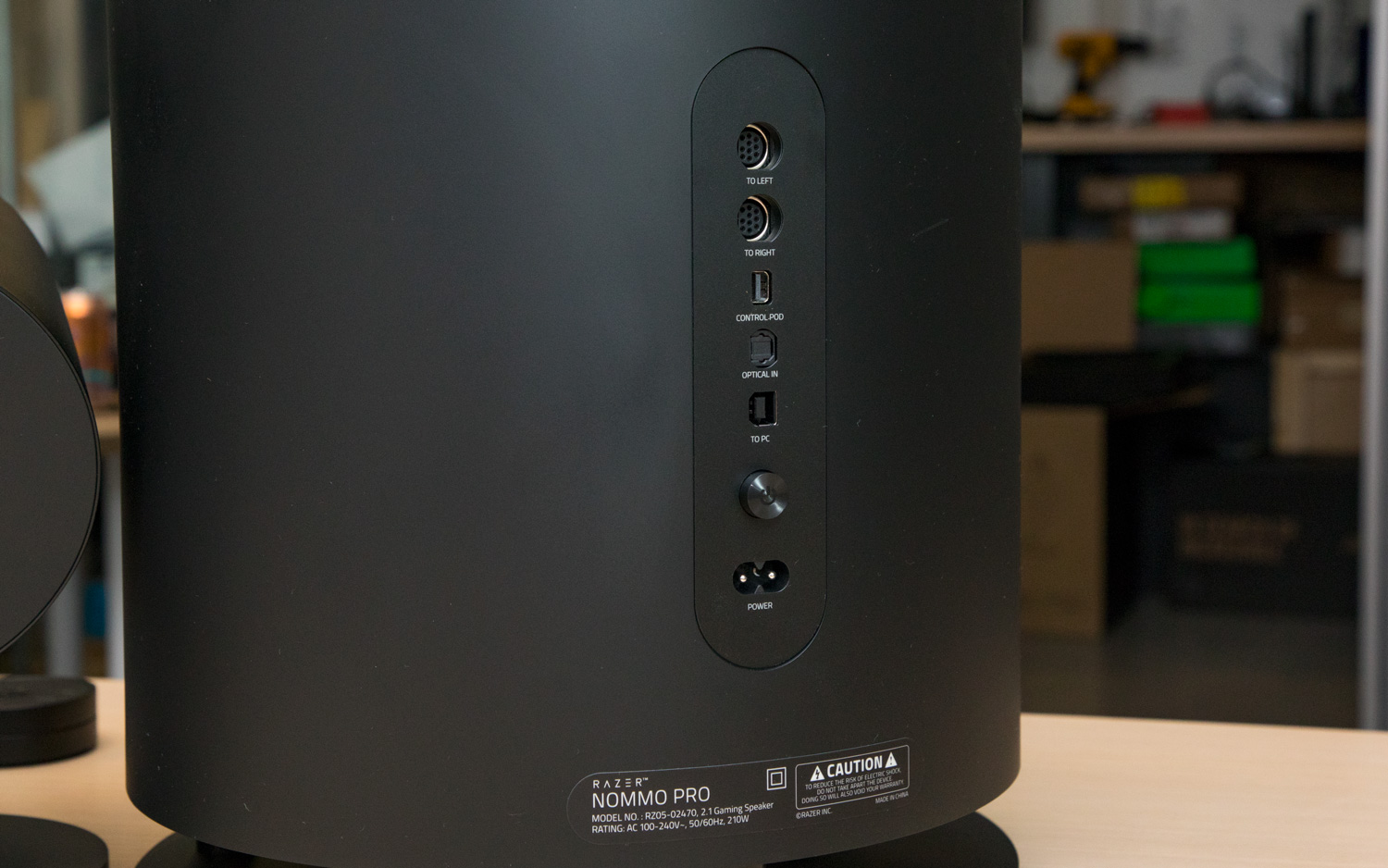
This feature worked particularly well in Overwatch, but honestly, what struck me most was the way it handled The Walking Dead. I never expected to need directional sound in a point-and-click adventure game, but hearing rustling leaves and low moans coming from just off to the side was much more affecting than hearing them from a nonspecific point in the game world.
The system's THX Spatial Audio option gives a lot of depth and fidelity to games in which you need to know your opponents’ locations.
One major advantage of the Nommo Pro is that it’s capable of producing quality sound at quieter volumes. This may not seem like a big deal, but some gaming speakers start loud and get positively deafening. The Nommo Pro is fairly tame on lower volumes, and you can even tweak the bass boost on the subwoofer (although you can't turn the subwoofer off entirely, making it a little perilous for late-night play).
MORE: Gaming - Hardware, Software and Peripheral Reviews
This means that if you have roommates, spouses or children whom you want to avoid be disturbing, you can still enjoy high-fidelity game audio without a headset. Of course, if headphones are your only option, you can just plug a pair into the analog jack on the control dongle. If nothing else, the Nommo Pro is versatile.
Software
The Nommo Pro runs on Razer's Synapse 3 software. Without going into exhaustive detail, I'll say that Synapse 3 has its pros and cons, but once you get a handle on it, it's not too difficult to use. As long as the Nommo Pro is connected to a PC, you can modify audio options for any one of the system's four connections. This is a particularly nice touch, because some gaming speakers will let you modify only PC audio options.
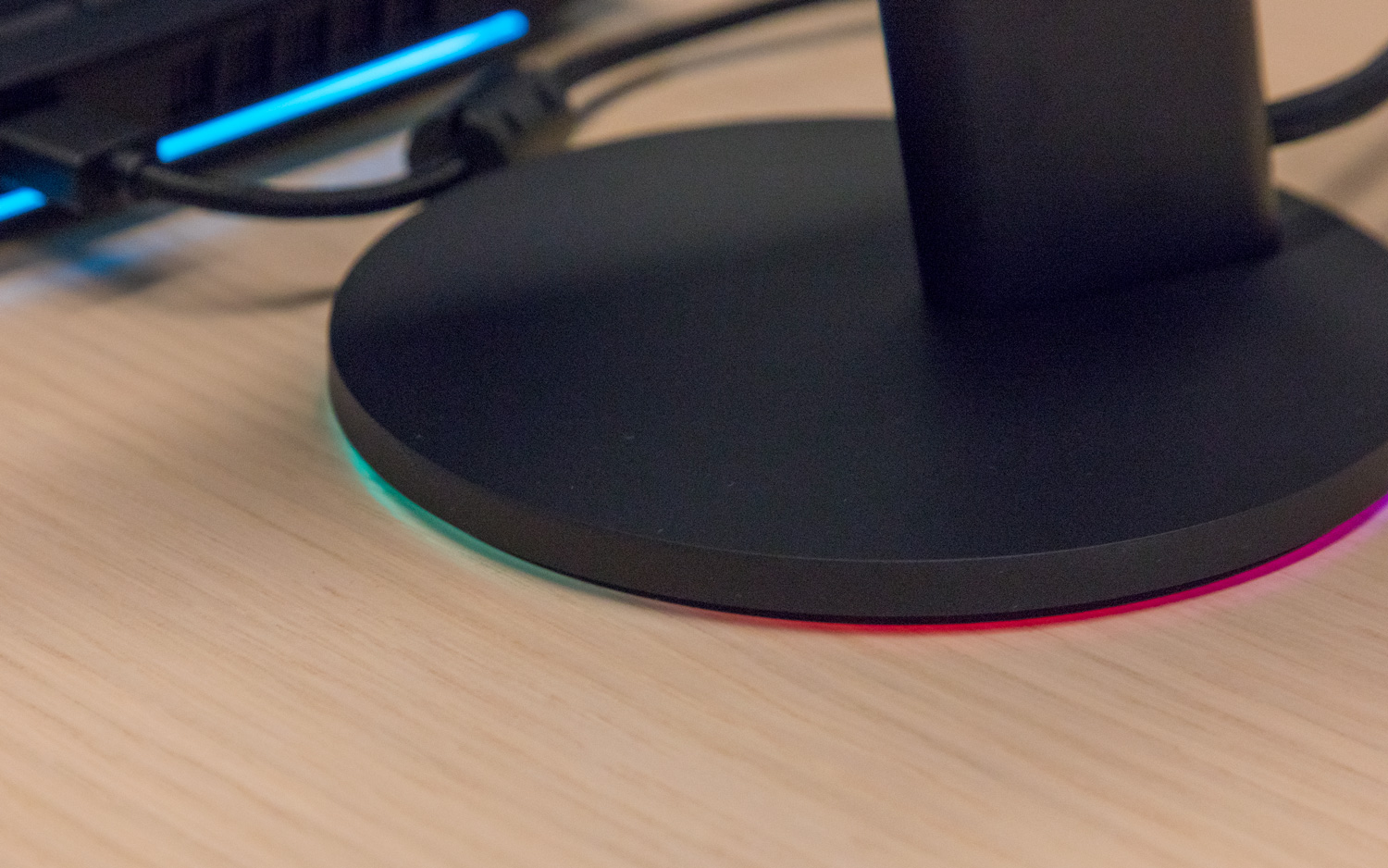
There are plenty of features for those who like to tweak. The THX Spatial Audio is the best all-around option, but you can also try Dolby virtual surround sound if you want something with a little more distance. (Think "concert hall" rather than "studio album.") You can also tweak individual equalization profiles — and with the Razer synapse software, you can link custom profiles with individual games. If you have an hour or so on your hands, you can do some pretty nuanced things with your go-to games and media apps.
You can modify the subwoofer's overall bass boost without having to toy around in individual equalization profiles. This is also a nice touch, especially if you're gaming late at night and don't feel like shaking the whole house apart.
MORE: The Best Headsets for Immersive Gaming
You can also sync the Chroma lighting with other Razer gear, although, as stated above, the lighting options are pretty thin — both figuratively and literally — this time around.
Music Performance
Like with games, music sounds great on the Nommo Pro, as do other forms of multimedia. I put the speakers through their paces with selections from Flogging Molly, Old Crow Medicine Show, The Rolling Stones and G.F. Handel.

I could make out the urgent vocals and the twang of the bass in songs like "Carry Me Back to Virginia," while choral selections like "The Lord Gave the Word" resounded with depth and vibrancy. In each song, there was a nearly perfect harmony of vocals and instruments, and the bass was always present without being overwhelming.
Likewise, when I streamed Star Trek: The Next Generation on Netflix or watched Better Call Saul on Sling TV, the dialogue sounded crisp and clear, while the music and sound effects never overwhelmed the voice work.
MORE: PS4 Games: Our Staff Favorites
The only real criticism I have here is that the music performance didn't sound significantly better than what you'd get from a decent, nongaming speaker setup in the $200 range. So, if gaming is just one part of your multimedia experience, rather than the focus, you probably don't need the Nommo Pro.
Bottom Line
The Nommo Pro produces beautiful and subtle (or powerful and blaring — take your pick) sound for games and music alike. Thanks to its THX certification, it can handle directional sound like a high-fidelity headset, while it also gets the job done for just sitting back and watching TV.
However, there are enough drawbacks present to preclude an unqualified recommendation. The short wires and the lack of wireless controls make it difficult to put the Nommo Pro at the center of a living-room setup — even though that's where it would probably work best. The lighting is unusually subdued, compared to what you get with Razer's usual gaming lineup.
And then there's the issue of price. Spending $500 on a set of quality speakers is hardly unheard of, but it's a lot to ask when most gaming speakers have settled somewhere around $200. The Razer Nommo Pro sounds better than a set of $200 speakers, true, but the difference is a matter of degrees, not a night-and-day comparison.
If you're already invested in the Razer ecosystem and want a premium gaming experience, especially in your living room, the Nommo Pro is worth picking up. But if you don't need immersive surround sound, you can pick up a brand-new console and a standard $150 Razer Nommo Chroma and have enough money left over for a night on the town.
Credit: Razer

Marshall Honorof was a senior editor for Tom's Guide, overseeing the site's coverage of gaming hardware and software. He comes from a science writing background, having studied paleomammalogy, biological anthropology, and the history of science and technology. After hours, you can find him practicing taekwondo or doing deep dives on classic sci-fi.
